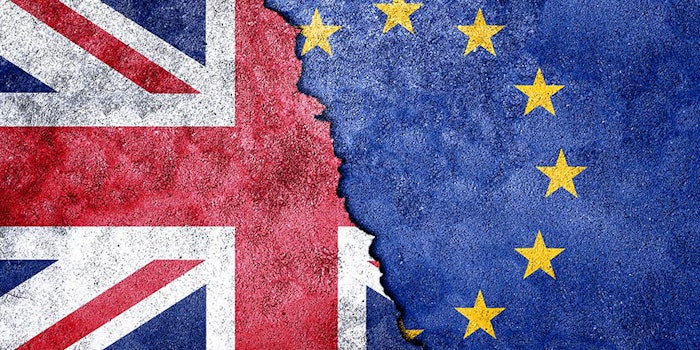
If you export cosmetic products to the United Kingdom, the European Union or both, it’s important to follow the developing regulatory obligations resulting from Brexit. After years of speculation and waiting, the United Kingdom formally left the European Union on January 31, 2020. What does this mean for U.S. cosmetics and personal care companies and what practical changes should your business start working on now?
Further reading: Brexit & Premiumization
Some of the new requirements for cosmetics as a result of Brexit will require action from brands and elements of their supply chain to maintain compliance for exported cosmetic products separately for the European Union and United Kingdom.
Let’s look at seven preparatory steps that can be started now, during the transition period, and the questions that still require answers from the European Union and/or United Kingdom before companies can be fully prepared and compliant by December 31, 2020.
1. Does This Impact You?
Essentially, if you export cosmetics to the European Union only and your responsible person (RP) is not presently located in the United Kingdom, nothing really changes your current obligations under EU Regulation 1223/2009, including annexes.
If you are exporting to the European Union and United Kingdom and currently have a RP in only in the European Union, please read on.
2. Sorting Out Your Responsible People
After December 31, 2020, you must have a distinct RP for the United Kingdom and another for the European Union. If you will export to both jurisdictions, there are several reasons to begin setting up your new RP as early in the transition period as possible, including:
- finding a reputable RP suitable for your business
- sufficient time to transition product registrations
- sufficient time to update product labels and manage inventory levels
If your current RP is based in the United Kingdom, that will not be sufficient for product exported to the European Union after December 31. However, UK RPs will remain acceptable during the transition period.
(Note, retailers and/or distributors may be enforcing their own requirement for earlier compliance, but this is not correct according to the agreement between the EU and UK governments.)
If your RP is currently based in the European Union and you will be exporting to the United Kingdom as well, your EU RP will not be sufficient after December 31, 2020. EU RPs will remain acceptable for United Kingdom product during the transition period.
3. Labeling Changes
Eventually, after the transition period ends, your product labels will need to reflect both RP addresses, or you will need to have separate EU and UK labels, each with their own respective RP address. The EU RP address is currently underlined on product labels.
It is yet to be determined what will happen when the UK RP address is added to the label under the yet-to-be-seen UK Cosmetic Regulation.
If the United Kingdom requires an underline as well, there could be issues with product exported to the European Union because the regulation stipulates that only the EU address be underlined. When it is eventually finalized, the language in the UK cosmetics regulation will be essential to understanding this labeling detail.
4. Product Information File (PIF)
You will need distinct product information files (PIF) for the United Kingdom and the European Union. This might require relabeling those products currently registered both for the United Kingdom/European Union since the location for the RP and PIF must be identified in both cases.
5. Product Registration
There will be two distinct registrations required for each product, one for the United Kingdom and the other for the European Union. After the transition period, UK entities will be deactivated/removed from the EU portal.
If you currently have a UK-based RP, it is recommended that you start moving your current product registrations over to your new EU RP within the existing registration portal system before the end of the transition period. The new UK registration portal is not yet available and does not currently have an expected go-live date.
6. Safety Assessors
It is expected that qualified UK safety assessors will remain valid options for safety assessments used for UK and EU products.
7. Remaining Unanswered Questions
It is understood that there are a number of unanswered questions concerning this major transition and that the status continues to evolve. Moving forward, the United Kingdom must:
- Implement new cosmetic regulations. It is not clear if the the country will adopt EU 1223/2009 without changes or how it will handle updates made by the European Union to the Cosmetic Regulation moving forward.
- Set up a portal or system for product registration.
- Decide how it will handle chemical management. Chemicals that are REACH-approved may not be approved by UK Chemicals Management. This is a matter of considerable discussion right now as it has potential for tremendous impact across all sectors.
Staying Vigilant
It appears that tensions are rising once again between UK and EU leadership with respect to the trade deal that still needs to be cut. It is important that we, as an industry, remain alert to and anticipate any changes from the status quo since they are bound to occur.
We will be monitoring the issue and report if something occurs.
For additional resources or to learn more about ICMAD, visit www.icmad.org; Meredith Petillo can be reached at [email protected].










